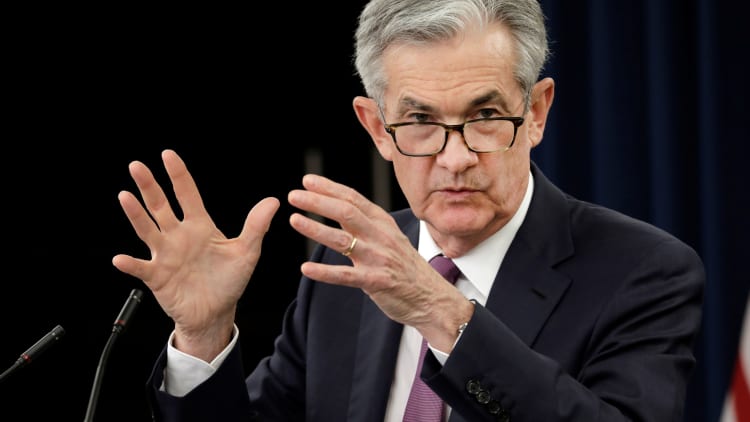
When the Fed releases minutes of its last meeting on Wednesday afternoon, it risks sounding a bit hawkish.
Going into that meeting three weeks ago, the Fed and the markets clearly held different views on whether the central bank needed to consider a pre-emptive interest rate cut. Fed Chair Jerome Powell knocked the idea of a rate cut as soon as the meeting ended when he said the Fed wasn't worried about low inflation and was content to be on hold.
But four days later, President Donald Trump tweeted about hitting China with new tariffs, and that changed everything. The futures market quickly priced in rate cuts for this year and next, and the idea of the so-called "insurance" interest-rate cut took on a new life as markets factored in potential economic weakness from the latest developments in the trade war.
Now, market pros are hoping the Fed minutes will reveal what Fed officials had to say about a possible rate cut, and they are looking for any signs that some members were more supportive of a cut.
Comments from St. Louis Fed President James Bullard fed speculation overnight, when he said the Fed may have "slightly overdone it" when it last raised interest rates by a quarter point in December.
"Rates are at a good place in the U.S. right now, if anything we are a little restrictive I would say," Bullard said on Bloomberg Television from Hong Kong. "I am concerned we may have slightly overdone it with our December rate hike, but I was pleased that the committee pivoted."
Joseph LaVorgna, chief economist Americas at Natixis, said Bullard's comments were dovish though the minutes could sound hawkish. "Get ready for the ease," he said. "The minutes are stale.The reason I think the minutes are mostly meaningless is we need to know what the Fed's new forecasts are and that doesn't come until June."
Economists said the Fed minutes could sound hawkish, since trade was a concern but at the time, it appeared a deal between the U.S. and China was in the offing. Now, talks have broken down, both sides have issued new tariffs, and the U.S. has put China's telecom giant Huawei on a blacklist.
"They don't even know what they're going to do next. The markets certainly do. It shouldn't really matter what the Fed thought in April," said LaVorgna.
S&P Global economists said the trade war could push the Fed toward a rate cut. The Federal Reserve is in wait-and-see mode, but the chance of an "insurance" rate cut has increased," the firm said in a note.
Jon Hill, BMO rate strategist, said any hawkishness on the economy that comes across in the Fed minutes should be "taken with a grain of salt" since the economy has clearly weakened.
"Even if the Fed sounds optimistic, the downside risks were disappearing. It was in the context of a different macro environment we were in. I would say that kind of information should be seen as relatively stale now," said Hill. He said there have been some significant signs of slowing since then, including ISM data.
The fed funds futures are currently pricing in 50% chance of a cut in September and a full 25 basis-point rate cut by December. Hill said another rate cut is reflected in the futures for next year.
"If Powell and others keep emphasizing they want to be patient, in some ways it's not being data dependent. What it's saying is we're going to look through the near-term data," Hill said. Referring to the personal consumption expenditure price index, he added: "The big question is whether low inflation is going to be transitory, especially the low PCE reading we got last month. If you look at other measures of inflation, the core PCE is an outlier."
Hotter inflation could encourage the Fed to raise interest rates, while weaker inflation, if it persists, could push the Fed to make the "insurance" cut to head off any softening of the economy. Powell, in his May 1 briefing, said the low inflation appears to be "transitory" and the Fed sees no reason to act at this point.
Powell indicated the Fed believes inflation will ultimately rise to or above its target of 2%, and that it could stay in a range on both sides of that level. Core consumer inflation was running at 2.1% annual in April, but it's the Fed's preferred gauge, PCE inflation, that matters more. The index rose 1.6% year on year in March, the smallest gain in 14 months. The April report is expected a week from Friday.
"Are they growing more or less concerned about inflation?" asked Mark Cabana, head of U.S. short rate strategy at Bank of America Merrill Lynch. "I think they'll say inflation has been low and they are going to be patient."
Cabana said if the Fed had seen any risks at the time of its meeting, it would see them even more skewed to the downside now
At the time of the Fed meeting, stocks were at record highs and there were some positive economic readings, in China and elsewhere. Since then, some Chinese data, like retail sales and industrial production have come in weaker than expected.
The hit a closing high on May 3, but it is now down nearly 3% for the month of May. At the same time, bond yields, which move opposite price, have moved lower. The 10-year was at 2.40% Wednesday morning, and the yield was at 2.119%.
Cabana said the minutes could also discuss the Fed's program to unwind its balance sheet and its decision to cut the interest rate on excess reserves.



